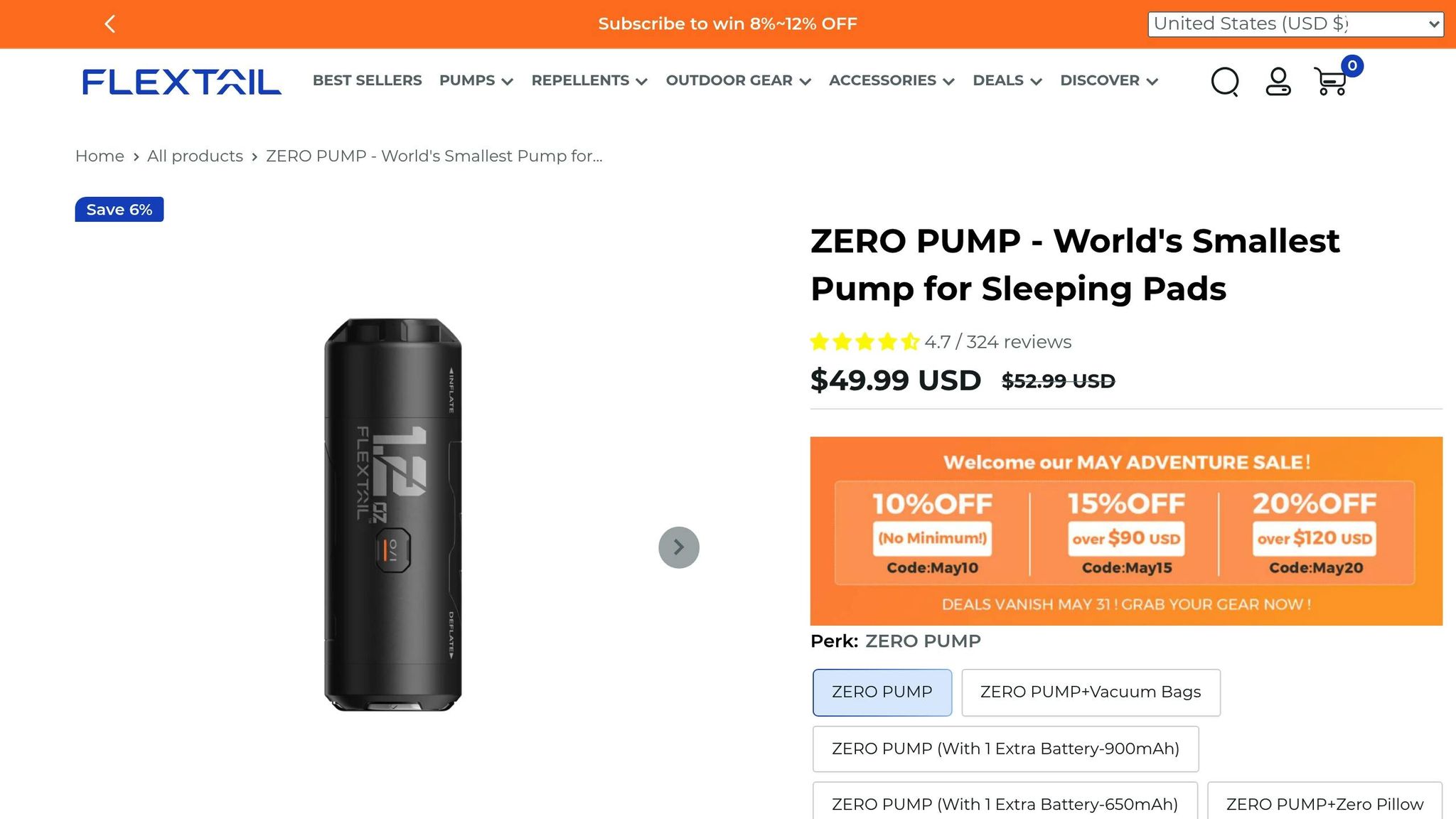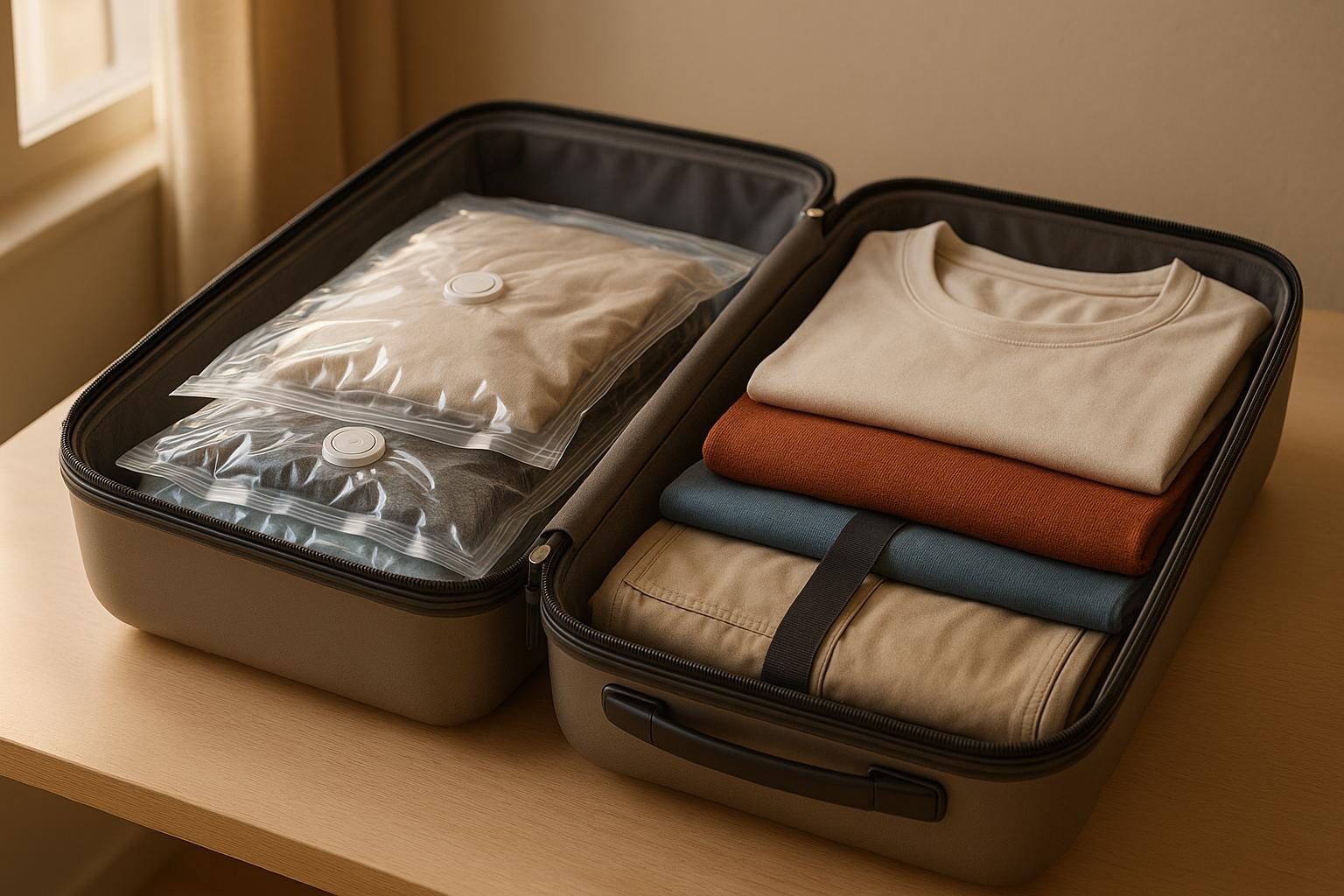Struggling to fit everything into your carry-on? Choosing between vacuum compression bags and traditional packing methods can make all the difference. Here's the quick breakdown:
- Vacuum Compression Bags: Shrink bulky items like winter gear by up to 80%, but they can wrinkle clothes and require extra tools for repacking.
- Standard Packing (Rolling/Folding): Easier and quicker for frequent access, but offers minimal space savings.
Quick Comparison
| Feature | Vacuum Compression Bags | Standard Packing |
|---|---|---|
| Space Savings | Up to 80% volume reduction | Minimal space reduction |
| Ease of Use | Slower packing, tools required | Quick and hassle-free |
| Clothing Care | May cause wrinkles and damage | Preserves fabric better |
| Repacking Convenience | Inconvenient mid-trip | Easy to adjust and repack |
| Best For | Bulky items (winter gear, bedding) | Everyday clothing, frequent access |
Tip: For efficient and organized travel, consider your trip type. Use vacuum bags for long stays or bulky items, and stick to standard packing for shorter trips with multiple stops.
Space Savings: Comparing Packing Methods
Volume Reduction Results
When it comes to saving space in your carry-on, traditional methods like rolling or folding clothes provide only limited results. On the other hand, vacuum compression can shrink textiles down to just 20% of their original size [1].
| Packing Method | Volume Reduction Potential | Best For |
|---|---|---|
| Vacuum Compression | Up to 80% reduction [1] | Bulky items like winter gear and bedding |
| Rolling/Folding | Modest space savings | Everyday clothing, preserving fabric shape |
The advantages of vacuum compression are most noticeable when dealing with bulkier items.
Packing Large Items
Vacuum compression is a game-changer for packing large, space-consuming items. It’s particularly effective for:
- Winter gear: Puffy jackets and sweaters compress to a fraction of their size.
- Bedding: Lightweight duvets made from cotton, linen, or bamboo are ideal candidates.
- Casual wear: Items like T-shirts, yoga pants, and pajamas work well for vacuum sealing.
That said, not everything benefits from compression. Structured garments, such as tailored suits, can lose their shape, and thick knitwear may not compress evenly [1].
Business traveler Mike shared that using vacuum storage bags significantly improved his packing efficiency [5]. His experience mirrors lab tests, which confirm that textiles can shrink to 20% of their original size [1].
It’s important to note that while vacuum compression dramatically cuts down on volume, it doesn’t reduce weight [7]. Make sure to keep airline weight limits in mind when packing!
Vacuum Bags for Carry-on Travel, Game Changer or Gimick? (Tested Using the Flextail Zero Pump)

Ease of Use and Convenience
When it comes to travel, saving space is essential, but it shouldn't come at the cost of convenience. Packing and repacking should be quick and hassle-free.
Time to Pack
Using vacuum compression bags adds extra steps to the packing process, which can slow things down. For instance, using a manual pump to remove air takes about 1.5 minutes per bag [4].
"My favorite part about this bag set is how effective the manual pump and valve was at sucking out air" [4]
If you're gearing up for a short trip, traditional methods like rolling or folding clothes are much quicker [3]. But packing isn't just about getting ready to leave - it’s also about how easy it is to adjust things during your journey.
Mid-Trip Repacking
Vacuum compression bags can become a headache when you need to repack on the go. If TSA opens your luggage for inspection, you might not have the tools handy to reseal the bags [8].
"The main disadvantage to using a vacuum sealed bag in your suitcase is that your clothes are going to be creased" [2]
For travelers who frequently need to reorganize their bags, roll-up compression bags are a more practical choice. While they don’t compress as much as vacuum-sealed bags, they don’t require any special tools and make mid-trip adjustments much easier [2].
Effects on Clothing and Materials
How you pack can directly influence the lifespan of your clothes. By understanding the impact of different packing methods, you can strike the right balance between saving space and keeping your garments in good condition - especially when preparing for travel.
Fabric Wear Analysis
Vacuum compression applies significant pressure to fabrics, which can potentially harm their structure. This is particularly true for items like tailored suits or garments with intricate details, as the pressure can distort their shape or damage delicate fibers.
The impact of compression depends largely on how long the clothing stays packed:
| Compression Duration | Effects on Clothing |
|---|---|
| Short-term (<1 week) | Minor wrinkles and temporary compression |
| Medium-term (1–6 months) | Possible loss of shape and deeper creases |
| Long-term (>6 months) | Higher risk of fiber damage and permanent misshaping |
Fabric Type Compatibility
The type of fabric plays a big role in how well it handles vacuum compression. Non-breathable plastic, often used in vacuum storage bags, can lead to creases and even damage, especially in delicate fabrics like silk or cashmere [10].
| Fabric Type | Suitable for Vacuum Compression? | Traditional Packing Recommended? |
|---|---|---|
| Cotton | Yes | Yes |
| Polyester | Yes | Yes |
| Denim | Yes | Yes |
| Silk | No | Yes |
| Wool | No | Yes |
| Cashmere | No | Yes |
| Leather | No | Yes |
Plant-based fabrics like cotton or linen can generally handle compression with just minor wrinkling. However, more delicate fibers - such as silk, wool, or cashmere - are prone to permanent damage when compressed [11].
If you decide to use vacuum storage bags, reserve them for sturdy fabrics and avoid using them as a long-term storage solution. For delicate pieces that must be vacuum-packed, wrap them in breathable garment bags first. This added layer of protection can help preserve the integrity of sensitive fibers while still saving space [1].
sbb-itb-b1567d8
Cost and Sustainability
When it comes to packing, cost and sustainability play a big role in decision-making. Both the financial aspect and the environmental impact should factor into your choice of packing method.
Long-term Environmental Effects
Traditional vacuum storage bags are made from non-biodegradable polyethylene, which takes a staggering 450 years to decompose [6]. This highlights the importance of seeking reusable and eco-friendlier options.
| Environmental Factor | Vacuum Bags | Compression Sacks |
|---|---|---|
| Material Durability | Prone to wear and tear | More durable |
| Replacement Frequency | Higher | Lower |
| Moisture Protection | Excellent | Good (waterproof options available) |
| Environmental Impact | Higher (non-biodegradable) | Lower (longer lifespan) |
| Volume Reduction | Up to 80% | Around 50% |
Vacuum bags are great for reducing packing volume by up to 80%, but they wear out faster and need replacing more often [12]. On the other hand, compression sacks, while reducing volume by about 50%, last longer and contribute less to waste over time [12].
Since durability affects long-term costs, it's worth weighing the environmental benefits against the price tag.
Price Comparison
Initial costs for these packing tools can vary significantly, which affects their overall financial value. High-quality vacuum bags typically cost about 50% more than basic compression sacks, with budget-friendly compression options starting at under $10 [12].
- Storage Master Vacuum Storage Bags: $17
- Gongshi Vacuum Storage Bags: $20
- Vacwel Vacuum Storage Bags: $31
While vacuum bags might seem pricier upfront, they can help save money by avoiding hefty baggage fees - potentially $50 or more per flight [12]. However, their shorter lifespan, caused by seal degradation and material wear, can diminish their long-term value.
When deciding, consider factors like the initial purchase cost, product durability, baggage fee savings, and the level of protection each option offers. Frequent travelers may find vacuum bags worth the investment for their space-saving benefits, while those focused on durability and reducing environmental impact might lean toward compression sacks [12].
Titantrek Atlas Vault Backpack Features

Titantrek has crafted a smart solution for travelers who face the challenge of packing efficiently within carry-on limits.
The Atlas Vault Backpack takes packing to the next level with its built-in vacuum compression system. This clever feature allows you to pack twice as much without changing the bag's external size. A small, pocket-friendly vacuum pump makes compressing and decompressing your belongings quick and hassle-free [13].
| Feature | Specification | Benefit |
|---|---|---|
| Dimensions | Depth expands from 5.9″ to 7.87″ | Flexibility for varying needs |
| Laptop Compartment | Fits laptops up to 17″ | Keeps electronics safe |
| Security | TSA-approved lock | Smooth airport security checks |
| Material | Waterproof construction | Protection in any weather |
Airline-Friendly Design
The Atlas Vault Backpack is designed to meet standard airline carry-on requirements, staying within the 22 x 14 x 9-inch limit. This ensures you can breeze through boarding without worrying about bag size [14].
Smart Space-Saving and Comfort
The standout feature of this backpack is its vacuum compression system, which helps you fit more while staying carry-on compliant [13]. Its expandable depth (ranging from 5.9″ to 7.87″) provides extra flexibility, while the ergonomic back panel, adjustable chest straps, and anti-theft pocket add comfort and security. Plus, the waterproof material ensures your belongings stay dry, no matter the weather [13].
At a discounted price of $199.00 (originally $250.00), the Atlas Vault Backpack also includes the vacuum compression pump, making it a reliable companion for travelers who need efficient packing on the go [13].
Conclusion: Making Your Choice
Vacuum compression can reduce luggage volume by as much as 80% [7], while standard packing allows for easier access to your belongings. Here’s a quick comparison to help weigh your options:
| Consideration | Vacuum Compression | Standard Packing |
|---|---|---|
| Space Savings | Reduces volume by up to 80% | Minimal space reduction |
| Clothing Care | May cause wrinkles | Preserves fabric better |
| Accessibility | Requires unpacking and repacking | Easy to retrieve items |
| Protection | Strong protection against moisture and pests | Basic protection only |
For those looking for a balanced approach, the Titantrek Atlas Vault Backpack offers a smart compromise. It combines effective compression with carry-on compliance, making it a great choice for frequent travelers [13].
When deciding between these methods, think about what your trip demands. Here are some tips to guide you:
- Opt for vacuum compression when traveling to a single destination for an extended period [9].
- Stick to standard packing for trips with multiple stops where you'll need frequent access to your items.
- For regular travel that requires both efficiency and convenience, consider hybrid solutions like the Atlas Vault backpack.
Ultimately, your packing strategy should align with your travel plans, ensuring you save space while keeping your belongings organized and well-protected.
FAQs
Do vacuum compression bags help reduce luggage weight and save on airline baggage fees?
Vacuum compression bags won’t make your luggage any lighter, but they can drastically improve how you pack. By compressing clothing and other soft items by up to 75%, these bags allow you to fit much more into your carry-on. This can mean skipping the need for an extra checked bag - and avoiding those annoying additional fees.
Although these bags won’t help you bypass airline weight limits, they’re fantastic for staying organized and making the most of your suitcase space. Plus, with overweight baggage fees for checked luggage running anywhere from $50 to $200 or more, smart use of compression bags can help you dodge extra costs and reduce the stress of packing for your trip.
What types of clothing or fabrics should I avoid packing in vacuum compression bags?
Not all clothing and fabrics are suited for vacuum compression bags, as the process can harm their texture or quality. It's best to avoid packing:
- Leather items: Compression can lead to deep creases that are tough to fix.
- Silk and delicate fabrics: Materials like chiffon or lace may get crushed under the pressure.
- Wool and cashmere: Flattened fibers can make these fabrics lose their softness and insulating properties.
- Garments with heavy beading or embellishments: These can lose their shape or suffer damage.
For these types of clothing, sticking to traditional packing methods will help protect their condition and appearance.
What are the environmental impacts of using vacuum compression bags versus traditional packing methods?
Vacuum compression bags come with both perks and drawbacks when you consider their impact on the environment. On the upside, they shrink the volume of packed items, making transportation more efficient and potentially reducing emissions. This compact design can also cut down on the need for extra packaging materials, which helps limit waste.
On the flip side, most vacuum bags are made from plastics that take hundreds of years to break down, adding to long-term pollution. The process of manufacturing and disposing of these plastics can also lead to higher carbon emissions. While they’re great for packing efficiently, their environmental cost is something eco-conscious travelers should keep in mind.

Vacuum Compression vs. Traditional Backpacks
5 Ways Compression Systems Reduce Travel Weight